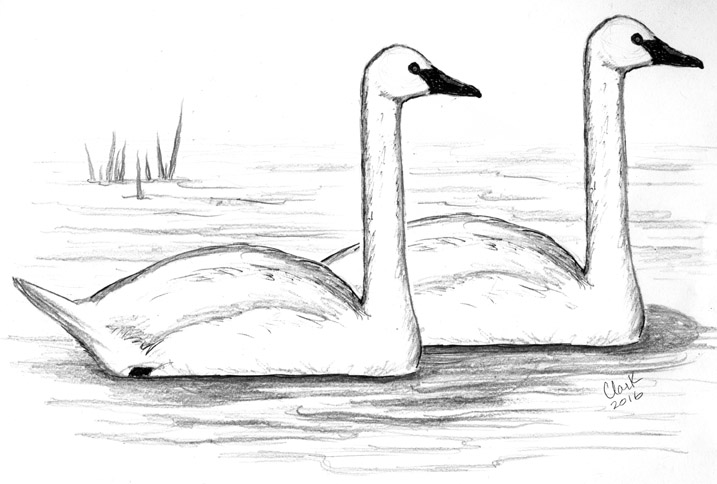
Dear Bird Folks,
I don’t know if anyone has ever taken the time to count the number of feathers that birds have, but I’d like to know which species has the most. I’d bet that title belongs to the ostrich. Am I right?
– Jackson, Falmouth, MA
Nope, Jackson,
You aren’t right. But don’t feel bad; I would have guessed ostrich myself, and why not? Those birds are huge. They stand nearly nine feet tall and weigh over three hundred pounds (which is actually my weight since the holidays). But ostriches are typically found in warm and drier climates and apparently don’t require a lot of extra feathers for insulation and waterproofing. With this theory in mind, you might assume that the bird with the most feathers would live in a cold climate and would spend a lot of its time in the water, and you would be right. (See, assuming doesn’t always make an a_ _ out of u and me, or whatever that lame expression is.)
It turns out the feather king is a swan. I didn’t know this little factoid until I got a new Jeopardy calendar for Christmas. One of the questions or “answers” (you know how Jeopardy likes to do things backwards) tells us that the Tundra Swan has more feathers than any other bird. Although Jeopardy called the bird by its old name: “Whistling Swan.” Maybe they weren’t aware of it, but that name was changed a few years ago when scientists realized swans can’t pucker and thus couldn’t possibly whistle. Alex Trebek should have known that, but I guess he was too busy learning how to pronounce all of those obscure French painters and weird biblical names. (How would you like to be on TV and try to say, “Habakkuk” or “Zebedee”?)
North America has only two native species of swans. By far, the larger of the two birds is the Trumpeter Swan. Found mostly in Western states, Trumpeter Swans were so relentlessly hunted that by 1935 only sixty-nine of these majestic birds were known to exist in the entire world. Fortunately, urgent conservation efforts paid off and today the giant swans are slowly making a comeback. In contrast, the much smaller Tundra Swans are doing just fine – although they are only occasionally spotted here on Cape Cod. Note: Neither of these two birds should be confused with the introduced Mute Swan. Mute Swans are quite common on the Cape. However, most wildlife officials consider them to be an invasive nuisance. Ironically, Mute Swans are loved by the general public, wedding planners…or anyone with a camera.
Now that we have all of our swan bios out of the way, let’s focus on the bird in question. As their name correctly implies, Tundra Swans are birds of the high Arctic, breeding in northern Alaska and Canada. Each spring the pen (female) lays 3-5 creamy-white eggs. She also does most of the incubating while the cob (male) stands guard and tries to figure out why his mate is called a “pen” and he is called a “cob.” (Whatever happened to good old drake and hen?) Since the Arctic breeding season is short, the young swans (cygnets) must grow quickly in order to join their parents on the long flight south. Many species of young birds migrate on their own, but Tundra Swans travel as a family unit. In late September they gather with other swan families before heading out. The flock will often travel up to 1,000 miles without stopping. The swans are able to make good time because they don’t have to stop at roadside rest areas along the way, which is lucky for them (although not so lucky for humans walking beneath them).
Wintering Tundra Swans split into two different populations, one in the East and one in the West. The Eastern birds habitually gather around Chesapeake Bay and coastal North Carolina. And while Mute Swans are basically silent (i.e., mute) Tundra Swans are a rowdy bunch. They incessantly yap to each other while feeding…but they don’t whistle. The bird’s alternate name, “Whistling Swan” is derived from the fact that their wings produce a whistling sound while in flight – Mourning Dove style.
So, how many feathers do these swans have? According to Jeopardy, they have an excess of 25,000 feathers, and that’s a lot. By comparison, our backyard birds (robins, doves, bluebirds, etc.) only have about 2,500. Even the mighty Bald Eagle is only covered in 7,000 feathers. What about the ostrich feather count, you ask? I tried hard to find out that piece of information but didn’t have much luck. Every ostrich book and website I checked only wanted me to buy ostrich feathers. Buy feathers? Yuck! FYI: If you care about birds, you should avoid purchasing anything made of the feathers. Those warm, fluffy feathers that some folks like so much are often ripped out of the birds while they are still alive. This includes feathers for pillows, dusters and those boas used by showgirls. Feathered boas are the main reason why I never watch showgirls on TV…especially when my wife is home.
The Tundra Swan is the feather champ, Jackson. I’m sorry I couldn’t back up your ostrich theory, but there is no way I would go against anything on a Jeopardy calendar. Jeopardy is one of the world’s most trusted sources of information. Oh sure, maybe they aren’t as factual as, say, the rock solid information found in this column, but they are still pretty good.